- Home›
- Beauty›
- International Yoga Day 2023- 6 Yoga Poses That Will Help You Treat Problem Of Hair Fall
International Yoga Day 2023- 6 Yoga Poses That Will Help You Treat Problem Of Hair Fall
By: Pinki Tue, 20 June 2023 08:36:16
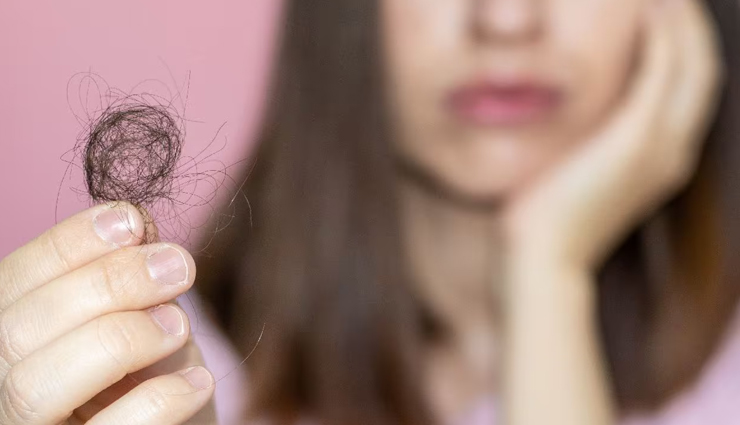
Yoga is a holistic discipline that combines physical postures, breathing exercises, meditation, and relaxation techniques to promote overall health and well-being. While it may not be a direct cure for hair fall, practicing yoga can contribute to the management and reduction of hair loss by addressing underlying causes such as stress, poor circulation, hormonal imbalances, and inadequate nutrition.
Hair fall can be caused by various factors, including lifestyle choices, genetics, hormonal changes, nutritional deficiencies, and stress. Yoga, when incorporated into a comprehensive approach to hair care, can help tackle some of these factors and promote healthier hair growth.
Firstly, yoga practices like deep breathing exercises and meditation can help reduce stress levels. Excessive stress is known to disrupt hormonal balance, leading to hair fall. By calming the mind and promoting relaxation, yoga can help minimize stress-related hair loss.
Additionally, certain yoga asanas (postures) can improve blood circulation to the scalp. Poses like Adho Mukha Svanasana (Downward-Facing Dog), Uttanasana (Forward Bend), and Sirsasana (Headstand) encourage blood flow to the head and scalp, thus enhancing nutrient supply to the hair follicles.
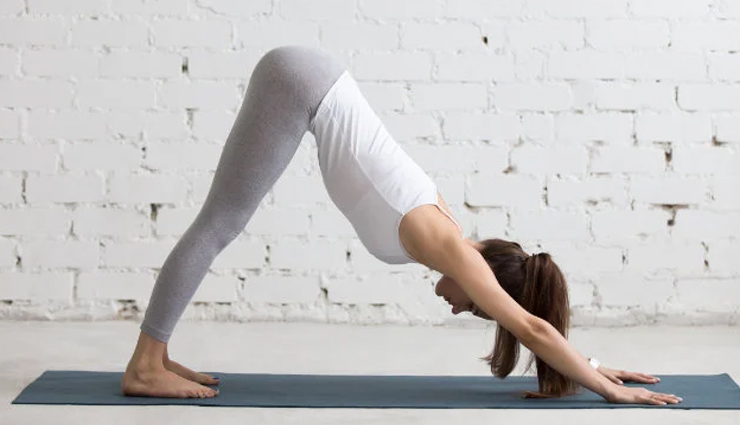
# Adho Mukho Savasana
The correct name for the pose you're referring to is "Adho Mukha Svanasana," which is commonly known as Downward-Facing Dog pose. Here's a step-by-step guide on how to practice this yoga pose:
- Start on your hands and knees, aligning your wrists beneath your shoulders and your knees beneath your hips. Spread your fingers wide, pressing through your palms and grounding your hands firmly into the mat.
- Tuck your toes under and exhale as you lift your knees off the mat, straightening your legs without locking your knees. Initially, you may keep a slight bend in your knees if it feels more comfortable.
- As you lift your knees, begin to lift your sitting bones toward the ceiling, creating an inverted V shape with your body. Lengthen your spine by reaching your tailbone away from your hands and your heels toward the floor.
- Keep your arms straight, and externally rotate your upper arms by turning your inner elbows towards each other. Engage your shoulders by drawing them away from your ears and broadening across your collarbones.
- Relax your head and neck, allowing it to hang freely between your upper arms. Gaze towards your feet or, if it feels more comfortable, towards your belly button or thighs.
- Press your heels down towards the floor, stretching through your calves and hamstrings. If your heels don't touch the mat, that's okay. Focus on lengthening the back of your legs while keeping your spine long.
- Hold the pose for 5-10 deep breaths, focusing on your breath and maintaining a steady, relaxed state. You can gradually increase the duration as you become more comfortable with the pose.
- To come out of the pose, exhale and bend your knees back down to the mat, returning to the starting position on your hands and knees.
Important tips:
- Make sure to distribute your weight evenly between your hands and feet.
- Keep your core engaged to support your spine and avoid sinking into your shoulders.
- Modify the pose as needed by bending your knees slightly or using props like blocks under your hands if you have wrist or shoulder issues.
Remember, it's always best to learn yoga poses under the guidance of a qualified yoga instructor, especially if you're new to yoga. They can provide personalized instructions and adjustments based on your individual needs and abilities.
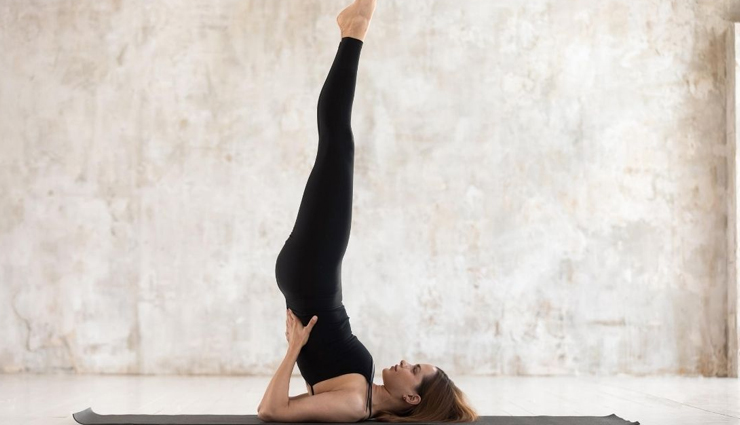
# Sarvangasana
Sarvangasana, also known as Shoulder Stand, is an advanced yoga pose that offers numerous benefits for the body and mind. Here's a step-by-step guide on how to practice Sarvangasana:
- Start by lying flat on your back on a yoga mat. Keep your legs together and your arms resting alongside your body, palms facing down.
- Take a deep breath in, and as you exhale, engage your core muscles and lift your legs off the ground, raising them perpendicular to the floor. Support your lower back with your hands, placing them on your hips for added stability.
- Continue to lift your legs upward, bringing them to a 90-degree angle with your torso. Maintain a firm grip on your lower back for support.
- Once your legs are elevated, gradually lift your hips and back off the ground. Use your hands to support your lower back, allowing your elbows to come closer together.
- As you stabilize your body, extend your legs upward, keeping them straight and active. Try to align your body in a straight line from your shoulders to your feet.
- Maintain a steady and comfortable breathing pattern throughout the pose. You can choose to rest your chin against your chest or keep your gaze toward your toes.
- Hold the pose for several breaths, gradually working up to a duration that feels comfortable for you. Beginners may start with 30 seconds to a minute and gradually increase their hold time over time.
- To come out of the pose, slowly lower your legs and back to the ground, releasing the weight from your hands. Allow your entire spine to rest on the mat, relaxing for a few breaths.
Important tips:
- Avoid any sudden or jerky movements while transitioning into or out of Sarvangasana.
- Ensure that your neck is aligned with your spine and that you're not straining it. If needed, you can use a folded blanket or a yoga prop under your shoulders to support your neck.
- If you're new to this pose or have any neck or shoulder issues, it's advisable to practice under the guidance of an experienced yoga teacher who can provide proper alignment cues and modifications.
Remember, Sarvangasana is an inversion pose that places pressure on the neck and shoulders. It's important to practice this pose mindfully, gradually building strength and stability. If you have any pre-existing health conditions or concerns, it's recommended to consult with a healthcare professional before attempting this pose.
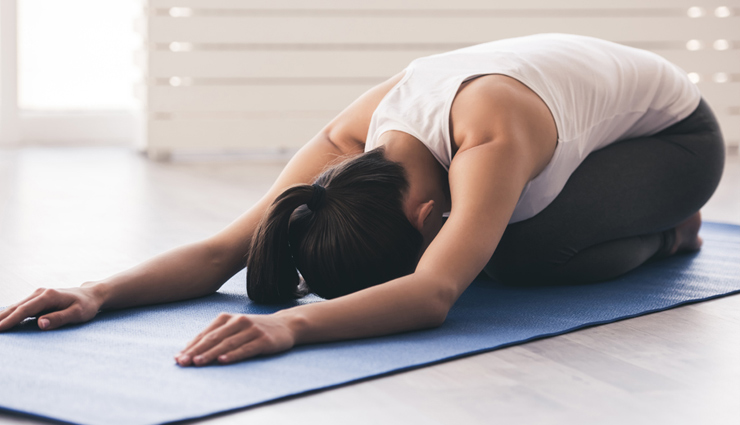
# Balasana
Balasana, also known as Child's Pose, is a gentle and restorative yoga pose that helps to promote relaxation, release tension, and restore energy. Here's a step-by-step guide on how to practice Balasana:
- Start by kneeling on your yoga mat. Bring your big toes to touch, keeping your knees slightly wider than hip-width apart. Alternatively, you can keep your knees together for a variation called Extended Child's Pose.
- Sit back on your heels and slowly lower your torso forward, allowing your forehead to come to rest on the mat. If your forehead doesn't comfortably reach the ground, you can place a folded blanket or bolster beneath your forehead for support.
- As you fold forward, extend your arms out in front of you, palms facing down. Relax your shoulders and let your hands rest on the mat.
- Gently lower your chest toward the ground, feeling a stretch in your back and shoulders. Allow your hips to sink towards your heels, creating a gentle traction in your spine.
- If it feels comfortable, you can choose to keep your arms extended or bring them alongside your body with your palms facing up, allowing your shoulders to relax completely.
- Close your eyes and focus on your breath. Take slow, deep breaths, allowing your body to relax and surrender into the pose.
- Hold the pose for as long as you feel comfortable, anywhere from a few breaths to several minutes. Allow yourself to fully unwind and let go of any tension or stress.
- To come out of the pose, gently press your palms into the mat and slowly lift your torso, bringing yourself back to an upright kneeling position.
Important tips:
- If you have knee or ankle issues, you can place a folded blanket or bolster between your hips and heels for added support and cushioning.
- Listen to your body and modify the pose as needed. If you experience discomfort or strain, adjust your positioning or use props to find a comfortable variation of Balasana.
- Balasana can be practiced at any time during your yoga session, as a resting pose between more vigorous asanas or as a standalone pose for relaxation and restoration.
Remember, Balasana is a calming and nurturing pose that allows you to connect with your breath and find a sense of grounding and relaxation. It's an excellent pose to release tension and restore your energy. Enjoy the soothing benefits of Child's Pose at your own pace and according to your own comfort level.
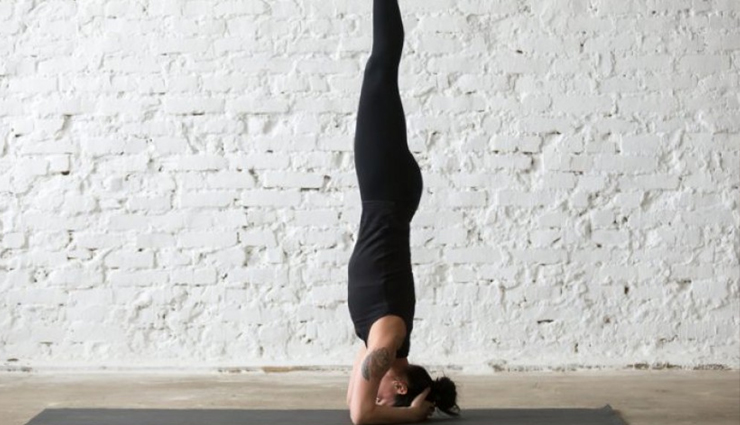
# Sirsasana
Sirsasana, also known as Headstand, is an advanced yoga pose that requires strength, balance, and proper alignment. It's important to approach this pose with caution and practice under the guidance of an experienced yoga teacher. Here's a general step-by-step guide on how to practice Sirsasana:
- Begin by kneeling on your yoga mat with your knees hip-width apart. Interlace your fingers and place your forearms on the mat, creating a triangle with your hands by extending your index fingers. Ensure that your elbows are shoulder-width apart.
- Place the top of your head on the mat, positioning it between your hands, with the back of your head resting against your interlaced fingers. Your head and hands should form a stable base for the pose.
- Tuck your toes under, lift your knees off the mat, and start walking your feet toward your head. Keep your legs straight and engage your core muscles to maintain stability.
- Slowly start to lift your legs off the ground, one at a time. Bend your knees slightly if needed, and then gradually extend your legs upward, straightening them as much as possible. Your body should form an inverted V shape.
- Keep your gaze fixed on a point on the floor to maintain balance. Avoid turning your head to the sides during the pose.
- Firmly press your forearms and palms into the mat, distributing your weight evenly. Engage your shoulder blades by drawing them away from your ears, and keep your neck relaxed.
- Hold the pose for a few breaths initially, gradually working up to longer durations as you gain strength and comfort. Focus on maintaining a steady breath and a calm state of mind.
- To come out of the pose, slowly bend your knees and lower your legs back down to the ground with control. Return to the kneeling position and rest in Child's Pose or another resting position to allow your body to recover.
Important tips:
- Practice Sirsasana under the guidance of a knowledgeable yoga teacher to ensure proper alignment and avoid injury.
- Avoid practicing Headstand if you have any neck or shoulder injuries, high blood pressure, or other contraindications. It's important to listen to your body and practice within your limits.
- Build strength and stability by gradually progressing through preparatory poses like Dolphin Pose, Forearm Plank, and Half Headstand before attempting the full Headstand.
- Utilize props like a wall or a partner to provide support and increase confidence when first learning the pose.
Remember, Sirsasana requires patience, practice, and a strong foundation of strength and alignment. Always prioritize safety and listen to your body. Practicing under the guidance of a qualified yoga instructor is highly recommended for mastering this pose.
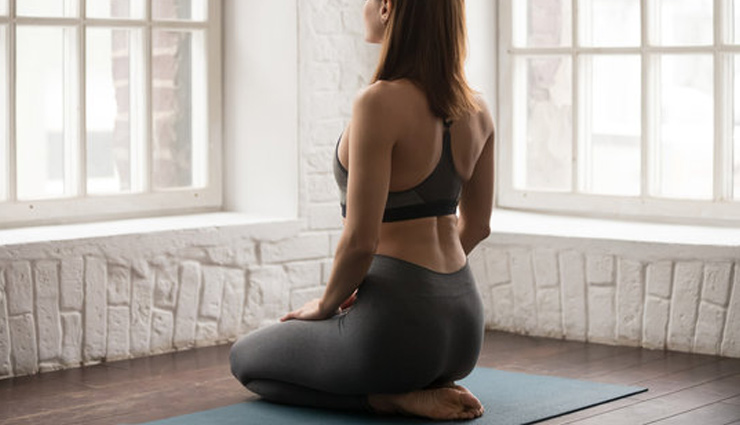
# Vajrasana
Vajrasana, also known as Thunderbolt Pose or Diamond Pose, is a simple yet powerful sitting pose in yoga. It is commonly practiced for meditation, pranayama (breathing exercises), and digestion. Here's a step-by-step guide on how to do Vajrasana:
- Start by kneeling on the floor or yoga mat. Keep your knees together and your feet slightly apart, with the tops of your feet flat on the mat. Your big toes can touch or be slightly apart, depending on your comfort.
- Slowly lower your buttocks onto your heels, allowing your weight to rest evenly on both legs. Place your hands on your thighs, palms facing downward.
- Lengthen your spine, sitting up tall. Align your head, neck, and spine in a straight line. Relax your shoulders and keep your chest open.
- Find a comfortable position for your hands. You can place them on your thighs with your palms facing down or rest your hands on your knees with your palms facing up, using the chin mudra (thumb and index finger lightly touching).
- Close your eyes or soften your gaze, and relax your facial muscles. Allow your breath to flow naturally, focusing on slow and deep inhalations and exhalations.
- Hold the pose for as long as you feel comfortable. Vajrasana can be practiced for several minutes or even longer during meditation or pranayama sessions.
Important tips:
- If you have any knee or ankle injuries or discomfort, you can modify the pose by placing a folded blanket or cushion between your buttocks and heels for added support and comfort.
- Be mindful of your body's limitations. If you experience any pain or discomfort, adjust the pose or come out of it gently.
- Vajrasana is generally safe for most people, but if you have any specific health concerns or conditions, it's advisable to consult with a healthcare professional or an experienced yoga teacher before practicing.
Vajrasana is a calming and grounding pose that promotes focused awareness and aids in digestion. It can be practiced at any time during the day, but it's particularly beneficial after meals to support healthy digestion.
Remember to listen to your body and practice with patience and awareness. Regular practice of Vajrasana can help improve posture, enhance digestion, and cultivate a sense of stability and grounding.
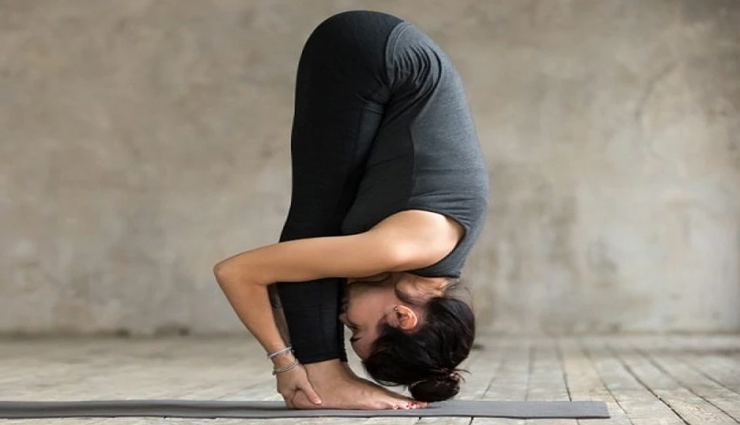
# Uttanasana
Uttanasana, also known as Standing Forward Bend or Forward Fold, is a rejuvenating yoga pose that helps to stretch the hamstrings, lengthen the spine, and promote relaxation. Here's a step-by-step guide on how to do Uttanasana:
- Begin by standing tall at the front of your mat with your feet hip-width apart and parallel to each other. Distribute your weight evenly between both feet.
- Take a deep breath in, and as you exhale, engage your core muscles and begin to fold forward from your hips. Keep your spine long and maintain a slight bend in your knees if necessary to avoid strain.
- Let your upper body hang freely as you bring your torso toward your thighs. Allow your arms to dangle towards the ground, either reaching for your shins, ankles, or placing your palms or fingertips on the mat beside your feet.
- Release any tension in your neck and shoulders, allowing your head to relax and your gaze to soften. You can gently nod your head or shake it from side to side to release any additional tension.
- Focus on your breath, taking slow and deep breaths as you settle into the pose. With each inhalation, feel your spine lengthening, and with each exhalation, allow yourself to relax deeper into the forward fold.
- If it feels comfortable, you can deepen the stretch by gently straightening your legs, aiming to bring your torso closer to your thighs. However, avoid forcing the stretch or compromising the length of your spine.
- Hold the pose for several breaths or for as long as it feels comfortable for you. Feel the stretch in the back of your legs and the release of tension in your upper body.
- To come out of the pose, slowly bend your knees and bring your hands to your hips for support. Engage your core muscles and use the strength of your legs to rise back up to a standing position, coming up slowly one vertebra at a time.
Important tips:
- If you have tight hamstrings or lower back issues, you can place a slight bend in your knees to alleviate strain and focus more on lengthening the spine.
- Avoid rounding your back excessively. Instead, prioritize maintaining a long spine, hinging at the hips, and folding forward from there.
- If reaching the ground is challenging, you can use yoga blocks or place your hands on your shins to modify the pose and adjust the level of intensity.
Remember to approach Uttanasana with a sense of gentle surrender and listen to your body's limits. Over time, with consistent practice, you may notice increased flexibility and a deeper sense of relaxation in this pose.





